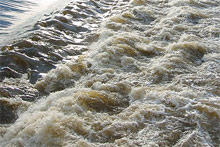Researchers at the University of Pittsburgh are using ionic polymers immersed in a river to generate ‘clean’ electricity for the city of Vandergrift, Pennsylvania. If the project is successful, the city’s downtown ‘could one day get 20 percent or more of its electrical power from a mile-long array of tiny plastic devices wiggling away on the bottom of the Kiskiminetas River as it sweeps around the town.
The development is performed in coordination with the town of Vandergrift, PA. The people of Vandergrift not only enable access to the river for prototype testing, but are also actively involved in the design process to insure that the ultimate device meets their expectations for maintaining the beauty and accessibility of their local river — the ‘Kiski’.”
This project is led by Lisa Mauck Weiland, a mechanical engineering professor at the University of Pittsburgh, who is directing the development of the Mechanics of Active Materials Laboratory of the Department of Mechanical Engineering and Materials Science.
Vandergrift, which is northeast of Pittsburgh, was originally supposed to be the model steel town, but now, as Weiland says, it is "reinventing itself and going for sustainability."
That sustainable power will most likely come from a grid of undulating strips made of polyvinylidene fluoride or PVDF, a material that generates a slight electrical current when it is moved, in this case, by the currents and eddies in the Kiskiminetas River. Such materials are described as piezoelectric, and the resulting electrical current would pass to small substations along the river's edge before charging a group of batteries.
"There are other materials that give better performance or have higher energy densities," said Weiland. "But we're willing to sacrifice a little power to keep the ecosystem happy."
The Kiskiminetas River, or the Kiski, as it's more informally known, is about 40 yards wide where it passes Vandergrift. Weiland currently plans to lay a grid, 30 yards wide and about a mile long, down on the river bed to help power the city.

